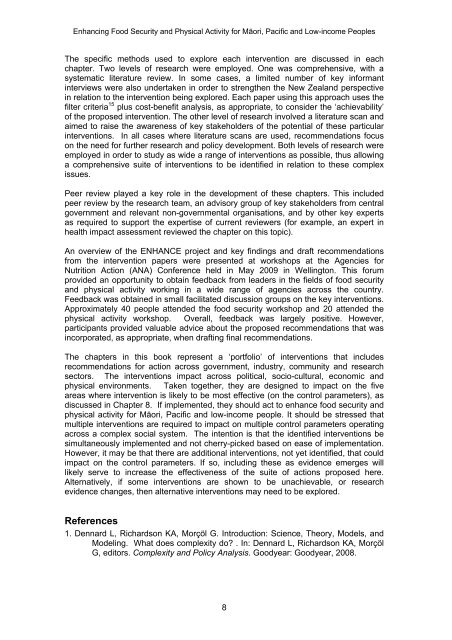enhancing food security and physical activity for maori, pacific and ...
enhancing food security and physical activity for maori, pacific and ...
enhancing food security and physical activity for maori, pacific and ...
- No tags were found...
Create successful ePaper yourself
Turn your PDF publications into a flip-book with our unique Google optimized e-Paper software.
Enhancing Food Security <strong>and</strong> Physical Activity <strong>for</strong> Māori, Pacific <strong>and</strong> Low-income PeoplesThe specific methods used to explore each intervention are discussed in eachchapter. Two levels of research were employed. One was comprehensive, with asystematic literature review. In some cases, a limited number of key in<strong>for</strong>mantinterviews were also undertaken in order to strengthen the New Zeal<strong>and</strong> perspectivein relation to the intervention being explored. Each paper using this approach uses thefilter criteria 15 plus cost-benefit analysis, as appropriate, to consider the ‘achievability’of the proposed intervention. The other level of research involved a literature scan <strong>and</strong>aimed to raise the awareness of key stakeholders of the potential of these particularinterventions. In all cases where literature scans are used, recommendations focuson the need <strong>for</strong> further research <strong>and</strong> policy development. Both levels of research wereemployed in order to study as wide a range of interventions as possible, thus allowinga comprehensive suite of interventions to be identified in relation to these complexissues.Peer review played a key role in the development of these chapters. This includedpeer review by the research team, an advisory group of key stakeholders from centralgovernment <strong>and</strong> relevant non-governmental organisations, <strong>and</strong> by other key expertsas required to support the expertise of current reviewers (<strong>for</strong> example, an expert inhealth impact assessment reviewed the chapter on this topic).An overview of the ENHANCE project <strong>and</strong> key findings <strong>and</strong> draft recommendationsfrom the intervention papers were presented at workshops at the Agencies <strong>for</strong>Nutrition Action (ANA) Conference held in May 2009 in Wellington. This <strong>for</strong>umprovided an opportunity to obtain feedback from leaders in the fields of <strong>food</strong> <strong>security</strong><strong>and</strong> <strong>physical</strong> <strong>activity</strong> working in a wide range of agencies across the country.Feedback was obtained in small facilitated discussion groups on the key interventions.Approximately 40 people attended the <strong>food</strong> <strong>security</strong> workshop <strong>and</strong> 20 attended the<strong>physical</strong> <strong>activity</strong> workshop. Overall, feedback was largely positive. However,participants provided valuable advice about the proposed recommendations that wasincorporated, as appropriate, when drafting final recommendations.The chapters in this book represent a ‘portfolio’ of interventions that includesrecommendations <strong>for</strong> action across government, industry, community <strong>and</strong> researchsectors. The interventions impact across political, socio-cultural, economic <strong>and</strong><strong>physical</strong> environments. Taken together, they are designed to impact on the fiveareas where intervention is likely to be most effective (on the control parameters), asdiscussed in Chapter 8. If implemented, they should act to enhance <strong>food</strong> <strong>security</strong> <strong>and</strong><strong>physical</strong> <strong>activity</strong> <strong>for</strong> Māori, Pacific <strong>and</strong> low-income people. It should be stressed thatmultiple interventions are required to impact on multiple control parameters operatingacross a complex social system. The intention is that the identified interventions besimultaneously implemented <strong>and</strong> not cherry-picked based on ease of implementation.However, it may be that there are additional interventions, not yet identified, that couldimpact on the control parameters. If so, including these as evidence emerges willlikely serve to increase the effectiveness of the suite of actions proposed here.Alternatively, if some interventions are shown to be unachievable, or researchevidence changes, then alternative interventions may need to be explored.References1. Dennard L, Richardson KA, Morçöl G. Introduction: Science, Theory, Models, <strong>and</strong>Modeling. What does complexity do? . In: Dennard L, Richardson KA, MorçölG, editors. Complexity <strong>and</strong> Policy Analysis. Goodyear: Goodyear, 2008.8
















